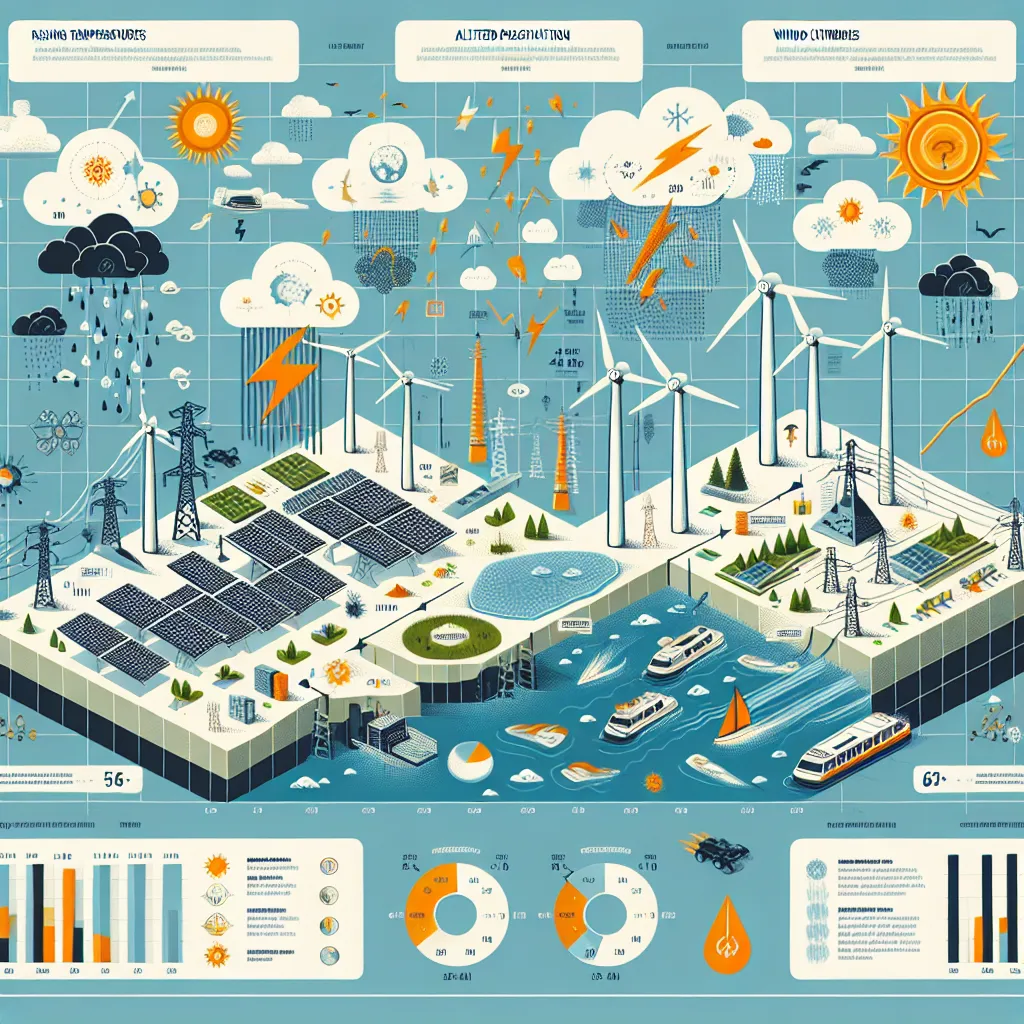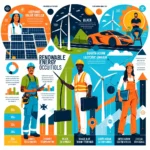Welcome to our IELTS Reading practice session focused on the effects of climate change on renewable energy potential. This topic has been increasingly prevalent in recent IELTS exams, reflecting its growing importance in global discussions. Based on our analysis of past IELTS tests and current trends, we anticipate this subject to remain highly relevant in future exams. Today, we’ll explore a passage that mirrors the complexity and depth you might encounter in the actual IELTS Reading test.
The IELTS Reading section requires you to demonstrate your ability to understand complex texts, identify key information, and interpret the author’s stance. Let’s dive into a practice text that will challenge these skills while exploring the critical intersection of climate change and renewable energy.
 Climate Change Impact on Renewable Energy
Climate Change Impact on Renewable Energy
Practice Text: Climate Change and Its Impact on Renewable Energy Sources
Climate Change’s Double-Edged Sword on Renewable Energy
Climate change, driven primarily by anthropogenic greenhouse gas emissions, is reshaping the global energy landscape in complex and often contradictory ways. While the push for renewable energy sources has gained momentum as a mitigation strategy against climate change, these very energy sources are not immune to the impacts of a changing climate. This paradox presents both challenges and opportunities for the renewable energy sector, necessitating a nuanced understanding of the interplay between climate change and renewable energy potential.
Solar energy, often hailed as a cornerstone of the clean energy transition, faces a mixed future in a warming world. On one hand, increasing global temperatures and changing cloud patterns could enhance solar radiation in some regions, potentially boosting photovoltaic (PV) efficiency. However, this benefit may be offset by the detrimental effects of extreme heat on PV panel performance and longevity. Studies have shown that for every degree Celsius rise in temperature above 25°C, the efficiency of silicon-based PV cells decreases by about 0.45%. Moreover, the increased frequency of dust storms and wildfires attributed to climate change could significantly reduce solar panel efficiency through soiling and atmospheric particulate matter.
Wind energy, another pivotal renewable source, is also subject to the whims of a changing climate. Alterations in global wind patterns, potentially linked to phenomena such as the weakening of the jet stream, could significantly impact wind farm productivity. Some regions may experience increased wind speeds, enhancing energy generation potential, while others might see a decline. The unpredictability of these changes poses a significant challenge for long-term wind farm planning and investment.
Hydroelectric power, which currently accounts for the largest share of renewable electricity generation globally, is perhaps the most vulnerable to climate change impacts. Changes in precipitation patterns, glacial melt rates, and the frequency of extreme weather events directly affect water availability and flow regimes. In some areas, increased rainfall could boost hydropower potential, while in others, prolonged droughts could severely curtail electricity generation. The case of Brazil’s hydroelectric sector during the 2015 drought, which led to a significant energy crisis, serves as a stark reminder of this vulnerability.
Bioenergy, derived from organic matter, faces its own set of climate-related challenges. Changes in temperature and precipitation patterns affect crop yields and the geographic distribution of suitable growing areas for bioenergy feedstocks. While some regions may benefit from extended growing seasons, others may face increased water stress and pest pressures, potentially reducing biomass productivity.
The geothermal energy sector, while generally considered more stable, is not entirely immune to climate change effects. Although the Earth’s internal heat is not directly affected by surface climate conditions, changes in precipitation patterns could impact the recharge rates of geothermal reservoirs in some areas.
Adapting to these challenges requires a multi-faceted approach. Technological innovations, such as more heat-resistant solar panels and wind turbines designed to operate efficiently in a wider range of wind speeds, are crucial. Diversifying the renewable energy mix and improving energy storage capabilities can help mitigate the variability introduced by climate change. Additionally, integrating climate projections into long-term energy planning is essential for building resilience in the renewable energy sector.
In conclusion, while climate change poses significant challenges to the renewable energy sector, it also underscores the urgent need for a transition away from fossil fuels. The renewable energy industry must evolve not only as a solution to climate change but also in response to its effects, ensuring a sustainable and resilient energy future.
Questions
True/False/Not Given
Determine if the following statements are True, False, or Not Given based on the information in the passage.
- Climate change affects all renewable energy sources equally.
- Rising temperatures always lead to increased efficiency in solar panels.
- Wind farm productivity may increase in some regions due to climate change.
- Hydroelectric power is currently the largest source of renewable electricity globally.
- Geothermal energy is completely unaffected by surface climate conditions.
Multiple Choice
Choose the correct letter, A, B, C, or D.
-
According to the passage, for every degree Celsius rise above 25°C, silicon-based PV cell efficiency:
A) Increases by 0.45%
B) Decreases by 0.45%
C) Remains unchanged
D) Doubles -
The impact of climate change on wind energy is described as:
A) Uniformly positive
B) Uniformly negative
C) Varying depending on the region
D) Insignificant -
The 2015 energy crisis in Brazil is mentioned as an example of:
A) Successful adaptation to climate change
B) The vulnerability of hydroelectric power to climate change
C) Increased hydropower potential due to climate change
D) The resilience of renewable energy systems
Matching Headings
Match the following headings to the correct paragraphs in the passage. Write the correct number (i-viii) next to questions 9-13.
i. The Variable Future of Wind Energy
ii. Bioenergy: A Climate-Sensitive Resource
iii. Solar Power: Balancing Gains and Losses
iv. Geothermal Energy’s Relative Stability
v. Hydropower: At the Mercy of Changing Water Patterns
vi. The Paradox of Renewable Energy in a Changing Climate
vii. Adapting Renewable Technologies to Climate Challenges
viii. The Urgent Need for Fossil Fuel Alternatives
- Paragraph 2 __
- Paragraph 3 __
- Paragraph 4 __
- Paragraph 5 __
- Paragraph 7 __
Summary Completion
Complete the summary below using words from the box. Write ONE WORD ONLY for each answer.
climate change | renewable energy | challenges | opportunities | adaptation | resilience | innovation | planning | diversification | storage
The relationship between (14)__ and (15)__ is complex, presenting both (16)__ and (17)__. To address these issues, several strategies are necessary:
- Technological (18)__ to improve equipment performance
- (19)__ of energy sources
- Improved energy (20)__ capabilities
- Long-term (21)__ that incorporates climate projections
These approaches aim to increase the (22)__ of the renewable energy sector in the face of changing climate conditions.
Answer Key and Explanations
True/False/Not Given
- False – The passage clearly states that different renewable energy sources are affected in various ways by climate change.
- False – The text mentions that while increased temperatures might enhance solar radiation in some areas, extreme heat can negatively affect PV panel performance.
- True – The passage states, “Some regions may experience increased wind speeds, enhancing energy generation potential.”
- True – The text explicitly states, “Hydroelectric power, which currently accounts for the largest share of renewable electricity generation globally…”
- False – The passage mentions that changes in precipitation patterns could impact geothermal reservoir recharge rates.
Multiple Choice
- B – The passage states, “for every degree Celsius rise in temperature above 25°C, the efficiency of silicon-based PV cells decreases by about 0.45%.”
- C – The text describes varying impacts on wind energy depending on the region, with some areas potentially seeing increased wind speeds and others experiencing declines.
- B – The Brazil example is used to illustrate the vulnerability of hydroelectric power to climate change impacts, specifically droughts.
Matching Headings
- iii – Solar Power: Balancing Gains and Losses
- i – The Variable Future of Wind Energy
- v – Hydropower: At the Mercy of Changing Water Patterns
- ii – Bioenergy: A Climate-Sensitive Resource
- vii – Adapting Renewable Technologies to Climate Challenges
Summary Completion
- climate change
- renewable energy
- challenges
- opportunities
- innovation
- Diversification
- storage
- planning
- resilience
Common Mistakes to Avoid
- Overgeneralizing: Be cautious about making broad statements. The passage often highlights regional variations and specific conditions.
- Misinterpreting “Not Given”: Remember, if information is not explicitly stated in the text, the answer is “Not Given,” even if it seems logical based on general knowledge.
- Overlooking qualifiers: Pay attention to words like “some,” “may,” and “could,” which indicate possibilities rather than certainties.
- Falling for distractors: In multiple-choice questions, some options may be partially correct. Always choose the most complete and accurate answer based on the text.
- Rushing through the summary: Take time to understand the context of each blank in the summary completion task. The correct word should fit grammatically and logically.
Vocabulary
- Anthropogenic: caused or produced by humans
- Mitigation: the action of reducing the severity, seriousness, or painfulness of something
- Nuanced: characterized by subtle shades of meaning or expression
- Photovoltaic (PV): relating to the production of electric current at the junction of two substances exposed to light
- Particulate matter: very small pieces of solid or liquid matter such as particles of soot, dust, fumes, mists or aerosols
- Whims: sudden changes of mind
- Regime: a system or ordered way of doing things
- Feedstock: raw material to supply or fuel a machine or industrial process
Grammar Focus
Pay attention to the use of conditional sentences in the passage, especially when discussing potential future scenarios. For example:
“While some regions may benefit from extended growing seasons, others may face increased water stress…”
This sentence uses the modal verb “may” to express possibility in the future. It’s a common structure in academic writing when discussing hypothetical situations or potential outcomes.
Tips for Success
- Time management is crucial. Allocate your time wisely across all questions.
- Read the questions before the passage to know what information to look for.
- Use skimming and scanning techniques to quickly locate relevant information.
- Pay attention to transition words and topic sentences to understand the passage’s structure.
- Practice regularly with various question types to improve your speed and accuracy.
Remember, success in IELTS Reading comes with practice and familiarity with different question types. Keep working on your vocabulary, reading speed, and comprehension skills. Good luck with your IELTS preparation!
For more practice on related topics, check out our articles on the effects of climate change on public infrastructure and challenges in international cooperation on climate policy.


